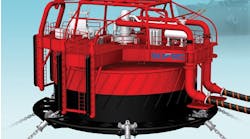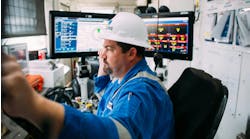The seismic industry has evolved over the last decade by increasing the volume of data that is typically acquired and processed by about an order of magnitude every five years. This trend is continuing today with the examination of not a single volume of 3D seismic data, but many different 3D-attribute volumes. Dynamic color-mapping and range-specific transparency make trends and patterns easy to find and explore further.
The result is that for some 3D surveys, the geophysicist must navigate his way through terabytes of seismic data. A more efficient means of working with such large volumes would translate into more time to derive a meaningful interpretation from it, which is, after all, the point of the whole exercise.
In response to this demand, Albuquerque-based MUSE Technologies has created a tool that addresses the specific requirements of the E&P marketplace, particularly in the area of SEG-Y interpretation. Based on specifications provided by Continuum Resources (CoRe), the company created a software tool known as TeraViztrademark that provides real-time interaction with hundreds of gigabytes (GB) of volumetric data on workstations equipped with just 1-2 GB of RAM.
This tool allows geophysicists to explore and manipulate extremely large volumes of data that would normally require significant installed memory. It allows rapid visualization of seismic volumes in a manner that divorces speed of inspection from volume size. In addition, the only limit on the volume size that can be inspected is the disk space available to actually store the seismic volumes. Dr. David Monk of CoRe summarizes the benefits in terms that a working geophysicist should appreciate:
- Rapid comparison of many attribute volumes
- Rapid visualization of un limitedly large volumes
- Accelerated identification of the most interesting areas of geology
- A rapid focus of effort in the areas of most importance.
Interpreters can control the virtual environment using voice commands and joysticks (or a conventional mouse), and can "fly" around and into volumetric data to see it from any angle or distance. The interpreter can also control the lighting and other aspects of the synthetic environment while viewing data. They can even share the environment with multiple simultaneous interpreters in different locations.
Segue from SEG-Y
SEG-Y, the oil industry's standard format for seismic amplitude data, was not designed to allow fast random access. For that matter, the "standard" often varies from one file to another. For these reasons, conversion tools reformat compliant SEG-Y files into the proper format. Non-compliant SEG-Y-like files can also be converted into usable form. Several SEG-Y files can be combined into a single file, assuming they have sequential crossline numbers (e.g. SEG-Y file 1 has crosslines 50-149, SEG-Y while file 2 has 150-229, and so on).
The automated conversion process, put briefly, rearranges SEG-Y's crossline/inline/ time into an xyz format such that time becomes y, inline becomes z, and crossline becomes x. As for x and z, all the vertices along one line map to the z axis at a single x coordinate. In other words, one line of data - all the vertices in one line and all those vertices' time samples - will lie in one yz plane. Each line of data maps to a different x coordinate (a different yz plane). The entire purpose of the converted format is to allow the fast random access that is crucial for unencumbered data exploration and thereby true interactivity.
Windows on the world
Once converted, the data is ready for viewing. When an interpreter launches the TeraViz tool, the resulting virtual environment consists of a large wireframe cube representing the entire volume. To see actual data, the interpreter invokes any of several viewing tools to create windows into the data.
The viewing tools include orthographic slices, cubes, and slice arrays; and free-motion slices and surfaces, which apply to in-memory sub-volumes. For example, the interpreter issues a simple command to create an orthographic slice (vertical or horizontal with respect to the volume).
- Slices: The slice appears as a plane or cross-section of amplitude data using standard colors: red for high amplitude and blue for low amplitude. The user can create multiple intersecting slices to zero in on patterns in the data.
- Cubes: Orthographic cubes essentially assemble six slices into a cube, any side of which can be made invisible to reveal relationships between other of the cube's intersecting slices.
- Arrays: Slice arrays consist of a series of slices and as such display a continuous chunk of data. All three tools can be used in combination to construct informative views of the data.
More importantly, all three have user-adjustable transparency. For example, a geophysicist might create a slice and move it through the volume to scan the data. The system's quick update rates allow him to keep track of the paths implied by the data's coloring. When he runs across an area of interest, he adds an array of slices and then adjusts the array's level of transparency so that only high-amplitude (red) data is visible - turning the array into a "cloud" of high-amplitude data.
Memory power
Orthographic slices, cubes and arrays all can be moved and resized within the data volume, but cannot be rotated. The software tool provides a special context for operations that require machine-memory speed, such as free movement of slices and creation of value-following surfaces: the in-memory sub-volume. As the name implies, an in-memory sub-volume is a subset of the entire volume that the interpreter loads directly into memory.
The process is straightforward. The user creates a candidate sub-volume (an empty wireframe), positions it to encompass the desired data, then commands the system to load the data into memory. Within that in-memory sub-volume, the interpreter can create and freely rotate slices, but can also create value-following surfaces using a simple algorithm included with the tool. Surface-picking allows the geophysicist to select a point within the data, then have the system generate a surface representing the continuation of that same value throughout the sub-volume. This is particularly useful for finding sand fans.
Although just recently introduced, the TeraViz tool has already proven its usefulness in the oil and gas industry by reducing the amount of time required to understand complex volumetric data. Power, capacity and ease of use virtually guarantee increased productivity for interpreters and engineers as they explore the voluminous, complex data that has become a trademark of the industry.


